These Car Emergency Kits Keep You Prepped for Inclement Weather and Mechanical Issues
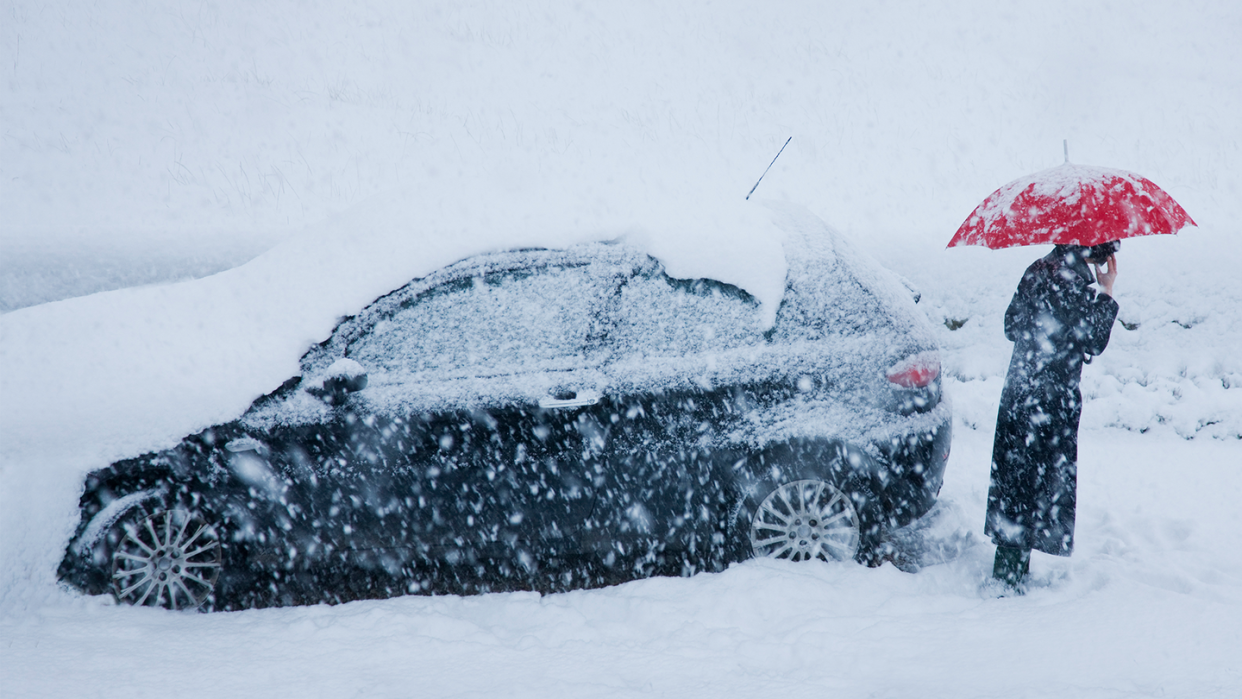
"Hearst Magazines and Yahoo may earn commission or revenue on some items through these links."
Keeping a car emergency kit in your vehicle is essential for safe road travel in the event you blow a tire, get stuck in a snow drift, or need to stay warm while waiting for a battery jump in sub-zero temperatures.
Roadside emergency kits come in various sizes with a variety of tools and safety items inside—you’ll find jumper cables, flares, tow ropes, hand tools, and first aid. Of course, you can put your own kit together using gear you already have—but if you’re starting from scratch, or prefer one that fits into a designated, organized container, these well-stocked car emergency kits are our top recommendations.
Best Car Emergency Kits
Best Overall: Haiphaik Emergency Roadside Kit
Best First Aid Kit: My Medic x Popular Mechanics The Auto Medic
Best For Cold Weather: Lifeline 4390 AAA Severe Weather Emergency Road Safety Kit
Best For Remote Travel: First Secure Emergency Roadside & First Aid Kit
Best Traction Kit: Oskar Three-Piece Emergency Kit
What to Consider
AAA—the industry leader in roadside assistance—recommends keeping several tools in your car at all times. The essential components for car emergency kits include:
Jumper cables
A tow rope
Basic first aid supplies
A flashlight
Flares or reflectors
Hand tools
You don’t need to buy the most expansive kit just because it has the most items and it seems like a good deal. If most of your driving is in warm-weather conditions, for instance, the ice scraper and fleece gloves might be overkill. Someone with a 3/4-ton pickup might want a tow rope with a higher weight capacity than someone who drives a Honda Civic.
What Is a Winter Car Emergency Kit?
Winter car emergency kits include traction aids that work well on ice, such as road salt, blankets, spare layers, a shovel, an ice scraper, and sometimes even a way to warm up. If you choose a winter kit, make sure to supplement it with other emergency items listed above, like jumper cables and flares.
Know How to Use Everything in Your Kit
Learning how to properly use each item in your emergency kit is just as important as the kit itself—otherwise, it’s just dead weight. If you’re overlanding or otherwise adventuring, we also recommend traveling in a group with at least one other vehicle if possible. Along with the fun factor of adventuring with your friends, having another vehicle around means there’s someone to help you out when things go south, whether you need a tow, a jump-start, or medical attention.
How to Use the Jumper Cables in Your Roadside Emergency Kit
Jumper cables require an additional car with a working battery, or a charged portable battery pack with jumper cable inputs.
Here are the steps to attach jumper cables.
Position the cars so the hoods are close, but not touching. This will allow the jumper cables to reach both batteries.
Turn off the ignition in both cars, open the hoods, and locate the batteries with markings for positive (+) and negative (-).
Your jumper cables have four color-coded clamps: two black and two red. Attach the red clamps to the positive terminal on the dead battery, then the live battery.
In the car with the charged battery, attach the black clamp to the negative terminal on the battery.
Finally, in the car with the dead battery, connect the remaining black clamp to an unpainted metal surface. We like to use a bolt positioned away from the battery to help prevent sparks.
To jump the dead car, simply start the engine of the car with the working battery to help run charge to the dead battery. After a few minutes, try starting the car. If it doesn't start, turn off the dead car’s ignition and try again after another three or four minutes.
Once you have the dead battery started, don’t turn off the car! You should let the engine run and drive the car for at least 30 minutes before you shut off the battery again.
In the meantime, you can remove the black cable from the formerly dead car, then remove the black cable from the fully charged car. Then remove the red cable from the charged car and, finally, remove the red clamp on the formerly dead car.
How to Use the Tow Rope in Your Roadside Emergency Kit
Your kit should come with a strong tow rope. When you receive your kit, inspect the rope to make sure it doesn't have any fraying or loose threading. To tow a car, first secure one end of the tow rope to the towing vehicle—that’s the car that isn’t stuck. Look for a hitch or tow loop to secure the rope to—not the bumper or the suspension. If the car doesn't have a clear hitch or loop refer to the owner's manual for the best place to secure the rope. You might need to get under the car to find a secure place to attach the rope, and make sure to use a strong knot like a bowline knot.
Next, secure the other end of the tow rope to the tow hook or loop on the stuck vehicle. Again, if it doesn't have a tow hook, follow the same steps to find a secure spot.
The driver of the stuck vehicle should stay in neutral with the engine off, and both drivers should communicate with hand signals for stop and go. Keep a safe distance between the cars, with the stuck-car driver in the vehicle, only turning on the ignition if you need power steering or braking. The driver of the towing vehicle should slowly move forward, and both drivers should monitor the stuck car's progress to avoid swinging or accelerating into the towing vehicle. Working slowly, the stuck car should gain traction and get back on the road.
How We Selected
Overlanding is an excellent arena for testing products in extreme conditions, and in selecting these items, we consulted overlanding expert Jon Tuico to find out what works best for him. Tuico has logged countless miles off-piste in his all-wheel-drive Honda Passport, tackling many landmark trail systems in the U.S.
Alongside Tuico’s overlanding expertise, our writers have spent a lot of time camping off-grid in trucks and vehicles. The items in these emergency kits have helped get us out of ditches, dig out from snow, get traction off-roading, jump-start other people’s vehicles, and spend the night in our cars unexpectedly.
Emergency Roadside Kit
Having this multifunctional emergency kit in your vehicle provides a solid lineup of essentials to use until help arrives. It comes equipped with items like jumper cables, a tow rope, a flashlight, gloves, and a survival whistle. It's also small and compact, and we love that everything is stowed in a hard-sided case with closures that are easy to open even with frozen fingers. The case lays perfectly flat on the ground, or on the hood or seat of your vehicle. The items are all secured in place with specific cutouts, helping you stay organized and level-headed in the moment.
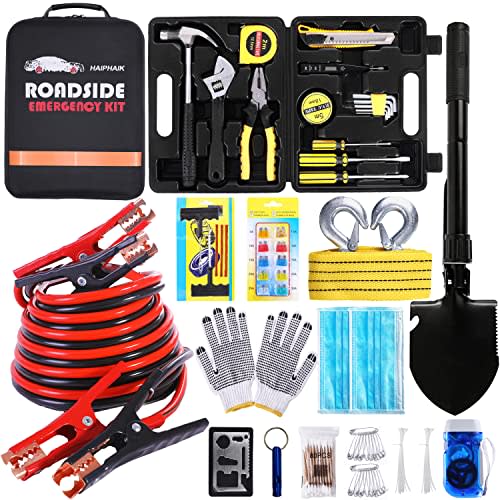
Emergency Roadside Kit
amazon.com
$49.90
Popular Mechanics The Auto Medic Emergency Kit
Popular Mechanics partnered with MyMedic to create the ultimate first aid kit for automotive use (it’s not bad for home and travel, either). If you have an accident or someone gets injured outside of cell service, it’s important to be able to tend to yourself and anyone else on board. In this kit, you’ll find—among other things—items like a window breaker and seatbelt cutter, MyMedic’s super-skin bandages, and a tourniquet. All of these first aid necessities come in a package that’s small enough to be easily stowed away in a seat-back pocket when not in use. Having a medkit is a great start, but, like we mentioned, be sure you know how to use everything inside.
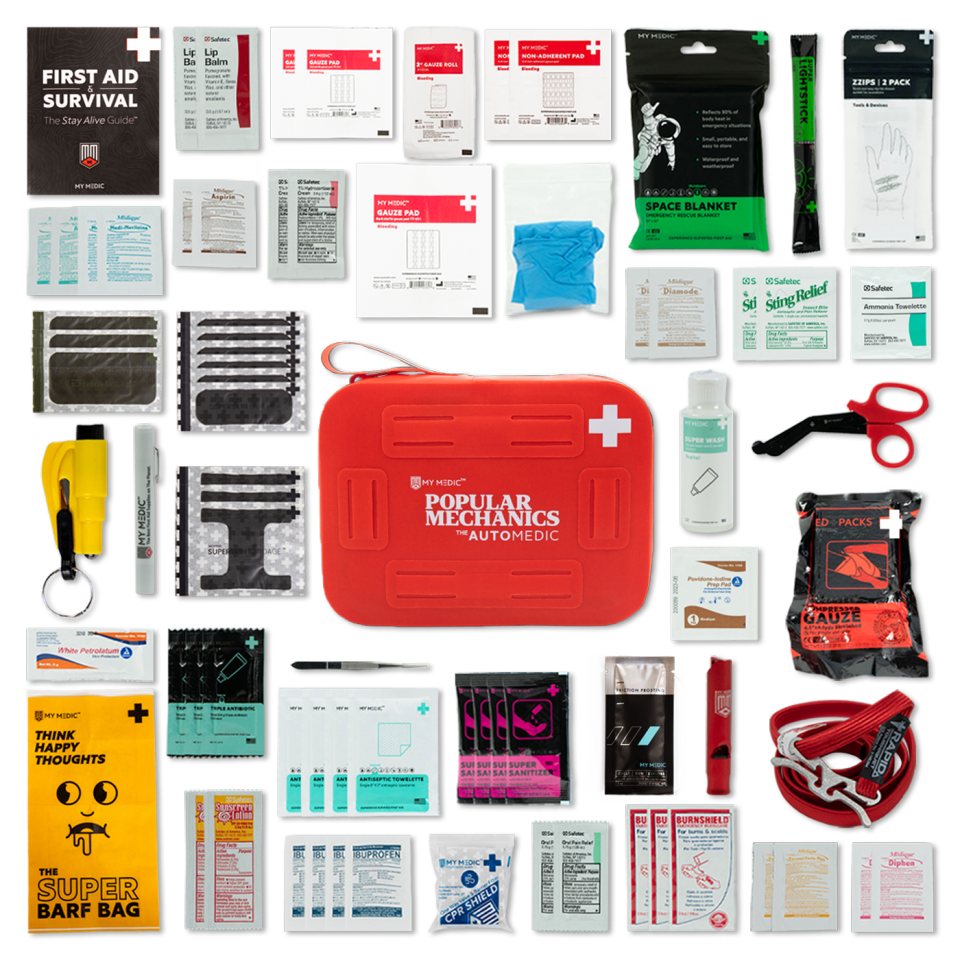
Popular Mechanics The Auto Medic Emergency Kit
mymedic.com
$99.95
390 AAA Severe Weather Emergency Road Safety Kit
This one is a great starter kit for cold-weather drivers who might find themselves stuck in a snowbank or stranded by the side of the road waiting for help. This 66-piece kit includes everything from basic bandages to a folding serrated-edge shovel to dig out of snow, all in a compact kit that weighs just over three pounds. This kit also comes with a fleece scarf and a set of gloves for warmth, as well as single-use hand warmers.
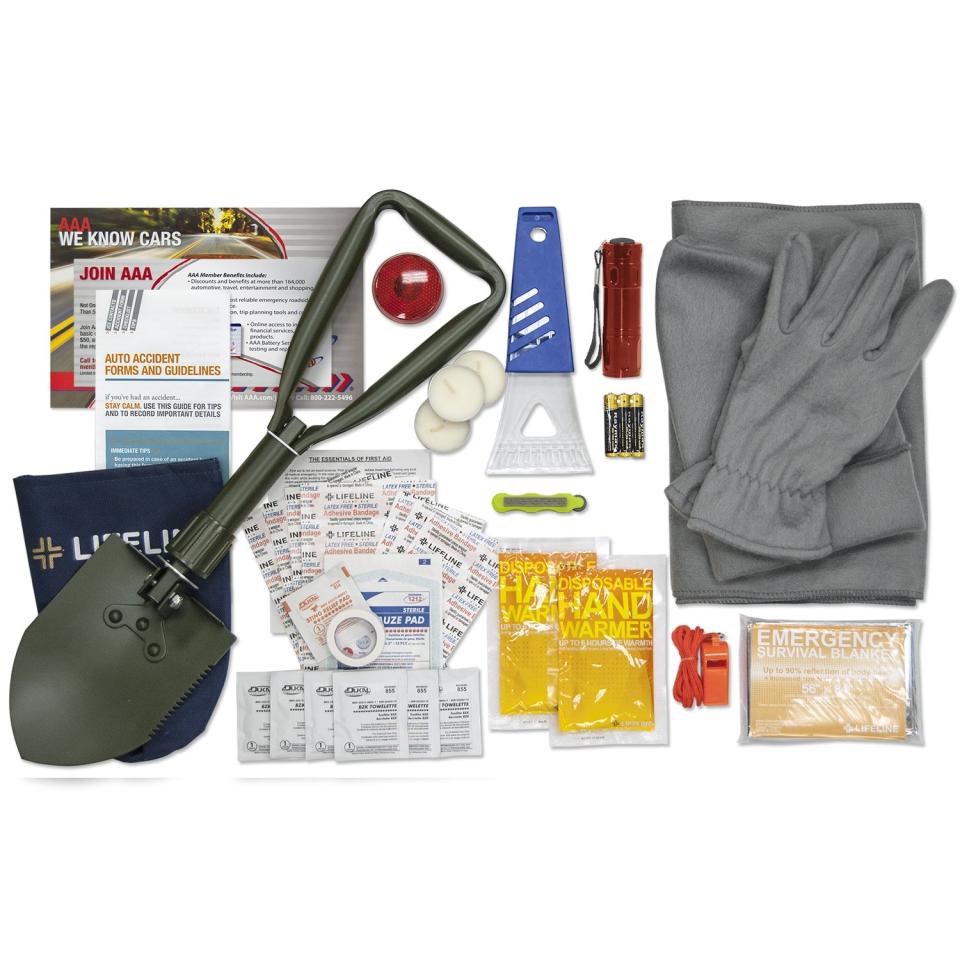
390 AAA Severe Weather Emergency Road Safety Kit
amazon.com
$54.99
Emergency Roadside Kit
Many ready-made emergency kits come with less-than-durable items, but this one has higher-end components to help with leaky tires and towing situations, whether it’s yourself or someone else you need to help. It comes with 10-foot jumper cables and a 10,000-pound high tensile nylon tow strap that measures just under 12 feet. We love the included headlamp (if you’re working under a vehicle, you’ll probably need both hands) and the basic tire repair kit and tire pressure gauge. Perhaps most important is the tough-yet-compact air compressor for inflating low tires and getting you back on the road.
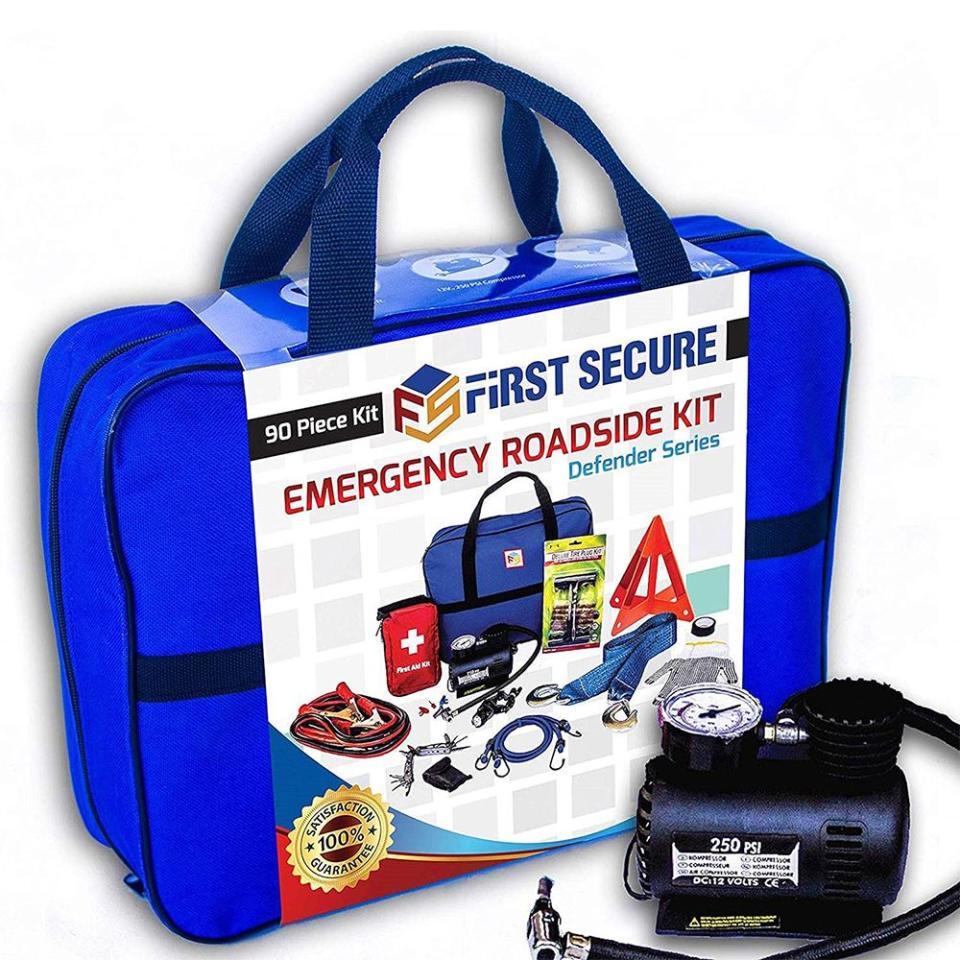
Emergency Roadside Kit
amazon.com
$69.95
Oskar Three-Piece Emergency Kit
As a supplement to a full emergency kit, this three-piece traction kit can be your ticket to getting out of slush, sand, mud, and compact or drifted snow. The highly reflective warning triangle has three bright reflectors, and the folding tire traction strips have a dual-hinged construction that helps them mold to the ground for the best possible traction on variable terrain.
Like higher-end traction strips, these have several different types of tread for giving your tires the best chance to grip and gain traction. The mats will work in temperatures as low as negative 40 degrees Fahrenheit, and can be stashed in your trunk or under a seat for quick access. Drivers in intense overlanding scenarios should certainly get a beefier traction set, but for the standard road tripper or commuter, these are a great (and compact) option.
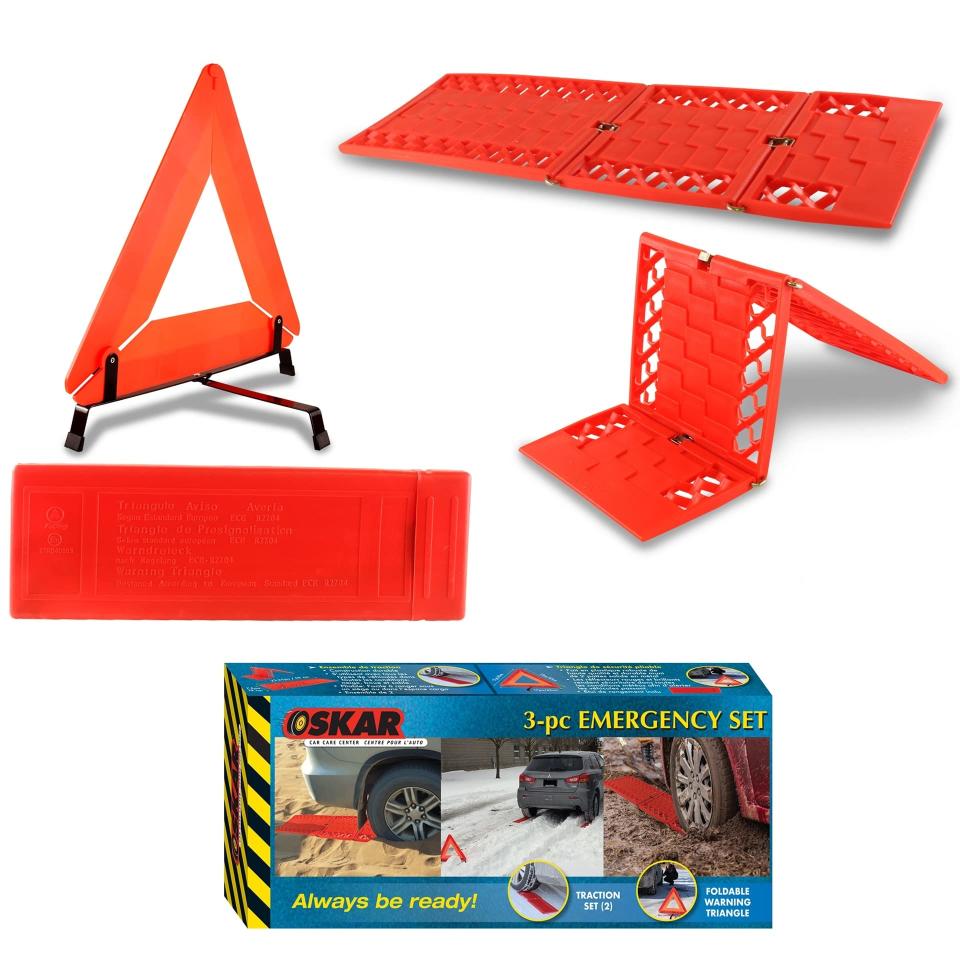
Oskar Three-Piece Emergency Kit
amazon.com
$20.83
You Might Also Like

